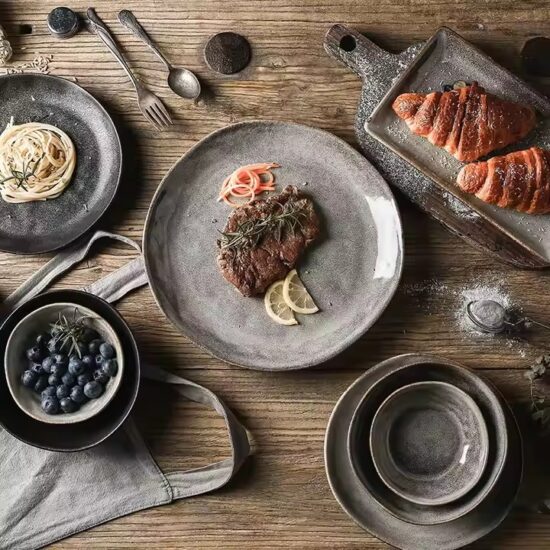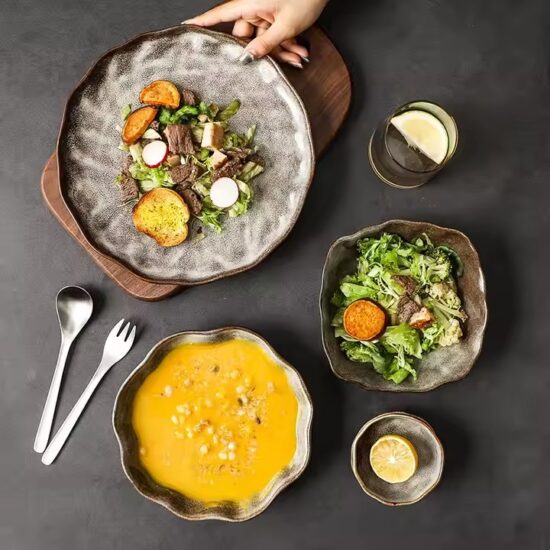bob@nbdho.com
Ceramic vs Bone China Dinnerware: What’s the Difference for Wholesale Buyers?
Ceramic vs Bone China – What’s the Difference?
When sourcing dinnerware for retail, hospitality, or custom branding, one of the most common questions is: Should I choose ceramic or bone china? Both are popular materials for plates, bowls, and cups—but they vary greatly in composition, durability, price, and market positioning.
In this article, we’ll break down the key differences between ceramic and bone china to help wholesale buyers, importers, and brand owners make informed purchasing decisions.
1. Material Composition
-
Ceramic Dinnerware
Made from clay and other natural materials. Fired at high temperatures and often glazed. Includes stoneware, porcelain, and earthenware. -
Bone China Dinnerware
A type of porcelain that includes bone ash (usually cattle bone), feldspar, and kaolin. It is fired at lower temperatures than standard porcelain, but results in a lightweight, elegant, and translucent finish.
2. Appearance and Aesthetic
-
Ceramic:
-
Heavier and more solid in appearance
-
Wide variety of colors, patterns, and finishes
-
Great for casual, rustic, or artisanal designs
-
-
Bone China:
-
Pure white, smooth, and semi-translucent
-
Known for its delicate, luxurious look
-
Ideal for high-end, elegant, or minimalist collections
-
3. Durability and Strength
-
Ceramic:
-
Strong and durable, but can chip or crack with rough handling
-
Stoneware is especially tough and great for daily use
-
-
Bone China:
-
Surprisingly strong for its light weight
-
Resistant to chipping but more sensitive to thermal shock (sudden temperature changes)
-
Often used in upscale restaurants and hotels
-
4. Weight and Handling
-
Ceramic Dinnerware is typically heavier and feels more robust, making it suitable for casual or family-style dining.
-
Bone China is lightweight, making it easier to handle in fine dining or banquet settings without compromising strength.
5. Price and Market Positioning
-
Ceramic:
-
Cost-effective to produce
-
Ideal for entry- to mid-level retail, promotional items, or high-volume supply
-
Great choice for OEM and private label clients targeting budget-conscious consumers
-
-
Bone China:
-
Higher production cost due to bone ash content and refined processing
-
Premium positioning, ideal for upscale branding, gifts, or formal settings
-
Attractive to luxury retail buyers and boutique hospitality clients
-
6. Applications and Target Markets
| Material | Ideal Use Cases | Target Buyers |
|---|---|---|
| Ceramic | Daily use, restaurants, fast casual dining | Mass-market retailers, hotel chains |
| Bone China | Weddings, fine dining, luxury branding | Boutiques, high-end hotels, gifting suppliers |
7. Customization Options
Both materials support:
-
Logo printing
-
Hand-painted designs
-
Reactive or matte glazes
-
OEM/ODM packaging
However, bone china is preferred when visual perfection and light translucency are essential, while ceramic allows for more artistic surface finishes and textures.
Conclusion
Choosing between ceramic and bone china depends on your product positioning, target customer, and use case. Ceramic dinnerware is ideal for practicality, durability, and flexibility in design, while bone china offers elegance, lightness, and a premium feel.
As an experienced ceramic and bone china dinnerware manufacturer, we provide tailored solutions for your brand or wholesale needs—whether you seek budget-conscious sets for daily use or refined luxury lines for high-end markets.
Looking for bulk ceramic or bone china dinnerware?
Contact us today for custom solutions, material comparisons, and factory-direct support.

